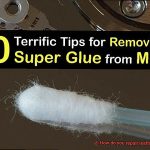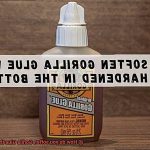Imagine this: you’re knee-deep in a project, meticulously applying super glue when disaster strikes. The lid gets glued shut, trapping that precious adhesive inside like a stubborn genie in a bottle. Frustrating? Absolutely. But fear not, my friends. Today, I’m here to share with you some nifty tricks on how to safely and effectively soften super glue in its confining container.
Super glue’s incredible strength is what makes it so desirable for bonding objects together. However, when it turns against us and locks itself away, it can be quite the sticky predicament. But worry not. There are ways to safely soften that stubborn super glue and make it usable again.
Join me on this adventure as we explore the world of sticky solutions, equipping you with the knowledge needed to conquer even the stickiest situations and restore that super glue bottle to its former glory.
Get ready for practical tips and mind-blowing facts that will forever change your perception of super glue and its untapped potential. So roll up those sleeves, grab your trusty reading glasses, and let’s dive into the secrets of softening super glue in a bottle.
Stay tuned for an enchanting journey filled with DIY magic that will have you saying “Abracadabra.” to locked-up bottles of super glue.
What is Super Glue?
Contents
- 1 What is Super Glue?
- 2 How Does Super Glue Become Hardened?
- 3 Heat Method: Applying Heat to Soften Super Glue
- 4 Acetone Method: Using Acetone to Dissolve the Glue
- 5 Commercial Remover Method: Using a Commercial Remover to Soften the Glue
- 6 Natural Degradation Method: Waiting for the Super Glue to Degrade Over Time
- 7 Safety Guidelines When Working with Super Glue
- 8 Conclusion
Super glue, also known as cyanoacrylate adhesive, is a remarkable adhesive that has found its way into countless homes, workshops, and industries. Its unmatched bonding properties have made it an essential tool for hobbyists, DIY enthusiasts, and professionals worldwide. In this article, we will explore the intriguing world of super glue and delve into its unique properties.
The Discovery
Super glue’s fascinating journey began in the 1940s when Dr. Harry Coover stumbled upon its incredible adhesive capabilities during a research project. Initially dismissed due to its tendency to stick to everything it touched, its exceptional bonding properties soon gained recognition, leading to its commercial production in the 1950s.
The Science Behind It
Super glue works by a process called polymerization. Its primary ingredient, cyanoacrylate, is a monomer that rapidly forms long chains of polymers when exposed to moisture. This happens within seconds, creating a strong and durable bond between surfaces.
Versatility and Applications
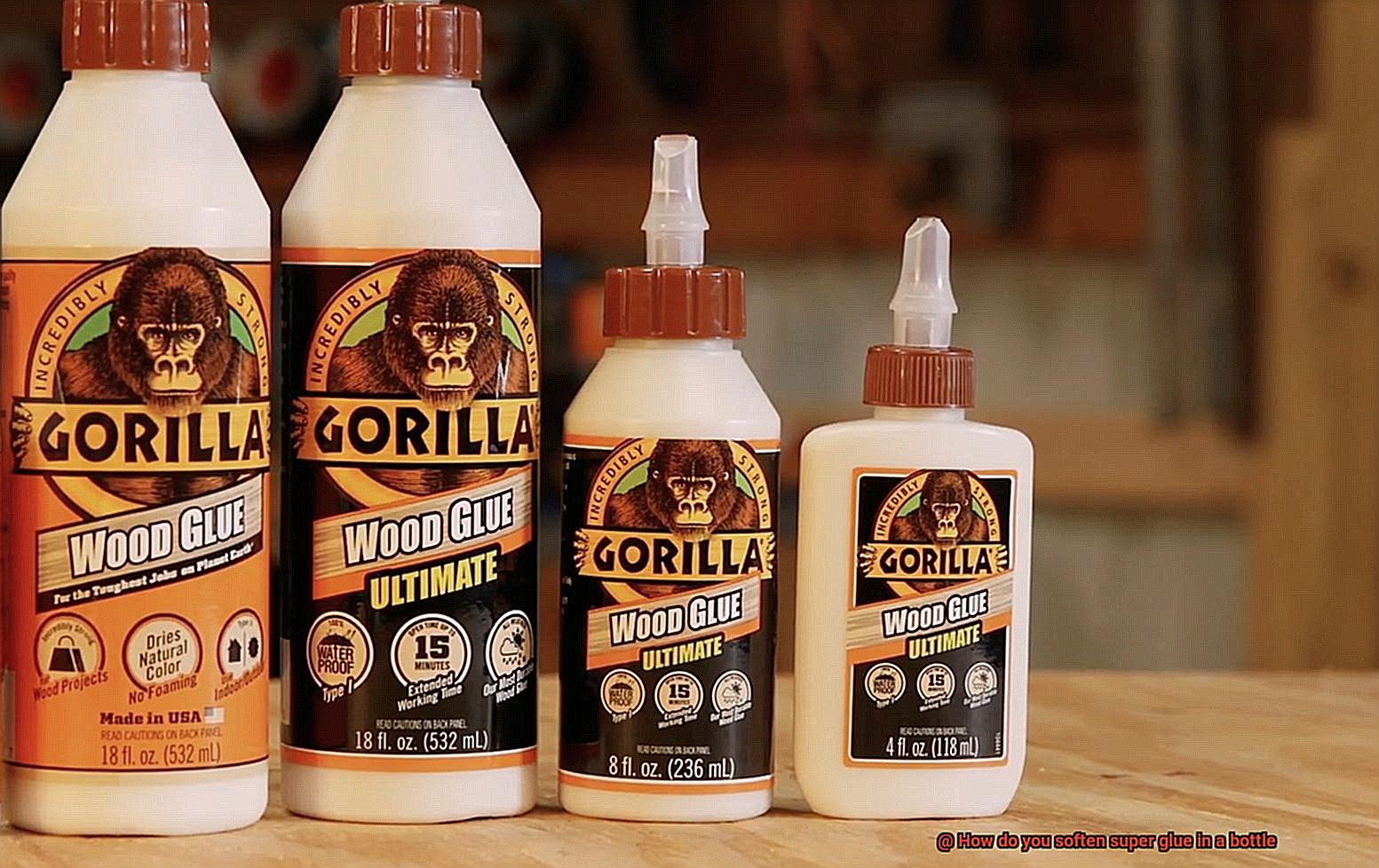
One of the standout features of super glue is its ability to bond various materials, including metal, plastic, rubber, ceramics, wood, and certain types of fabric. This versatility has made it indispensable in fields such as woodworking, jewelry making, automotive repairs, and more.
Different Forms for Different Needs
Super glue comes in liquid and gel forms. Liquid super glue is ideal for smooth surfaces and filling gaps, while gel super glue’s thicker consistency makes it perfect for vertical applications or bonding porous materials.
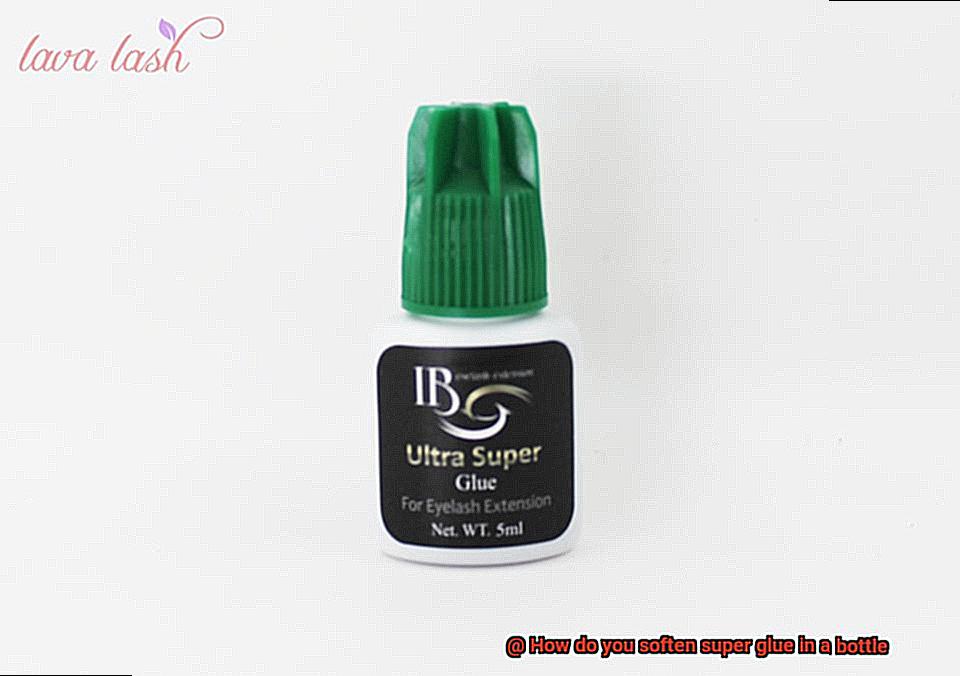
How Does Super Glue Become Hardened?
In this blog post, we will delve into the captivating science behind super glue and unravel its mysteries.
The Power of Polymerization:
At the core of super glue lies a mesmerizing process known as polymerization. When exposed to moisture, the liquid cyanoacrylate monomer undergoes a miraculous reaction, forming intricate chains of polymers. This rapid polymerization process occurs within seconds, creating a bond that defies pressure and holds materials together with unwavering strength.
Versatility at Its Finest:
One of super glue’s most astounding features is its remarkable versatility. It effortlessly bonds an array of materials such as metal, plastic, rubber, ceramics, wood, and even certain fabrics. This adaptability has made it an indispensable tool in countless fields, ranging from woodworking to jewelry making and automotive repairs.
Liquid vs. Gel:
To cater to diverse needs and preferences, super glue is available in two main forms: liquid and gel. Liquid super glue caters to smooth surfaces and fills gaps between materials with surgical precision. Conversely, gel super glue boasts a thicker consistency that excels in vertical applications or bonding porous materials requiring additional support.
Temperature Matters:
Temperature plays a significant role in the hardening process of super glue. Lower temperatures decelerate the polymerization reaction, while higher temperatures expedite it. Hence, it is advisable to store your super glue in a cool, dry place to prolong its shelf life.
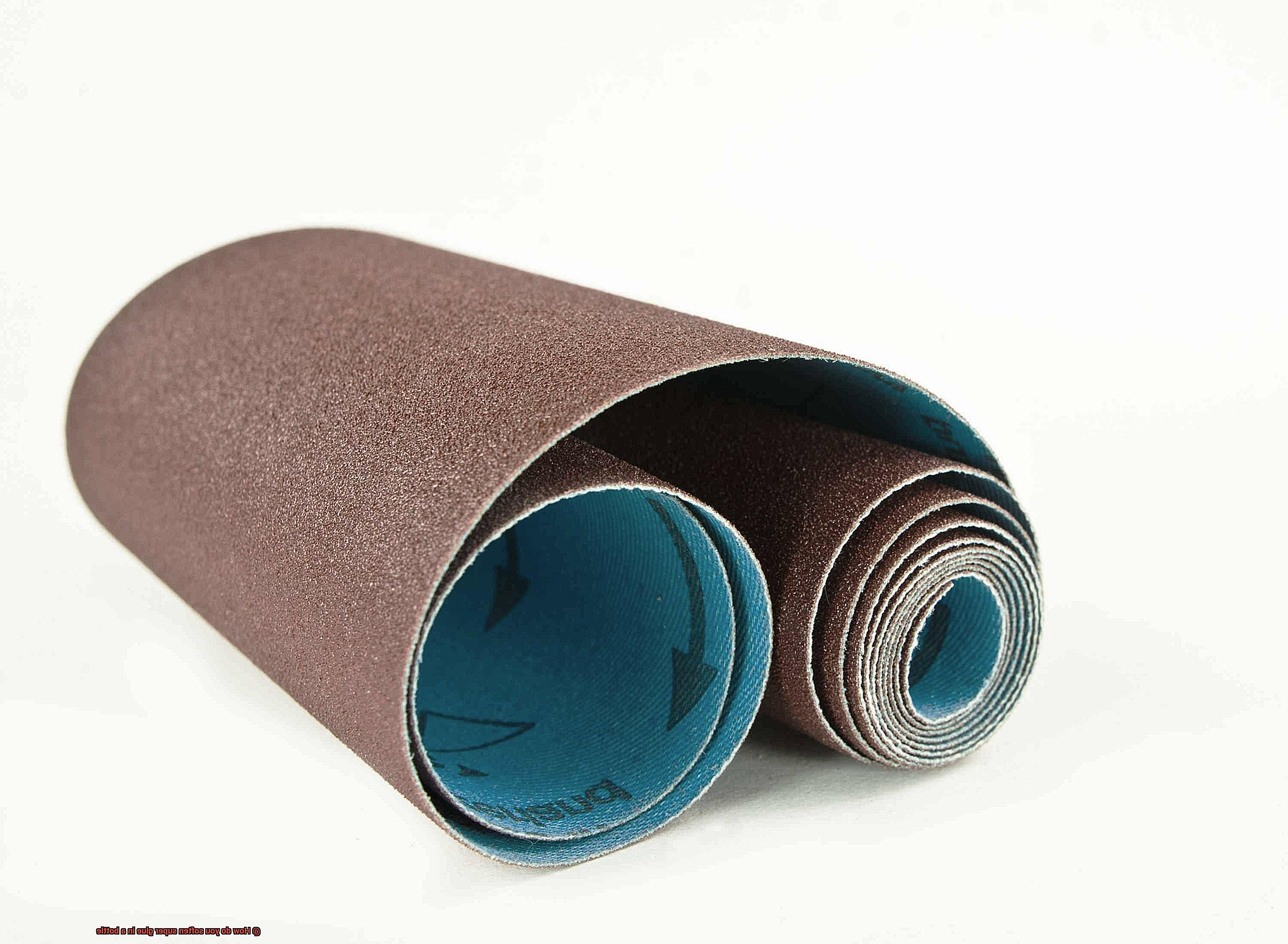
Removing Super Glue:
Once super glue has hardened, removing it can prove challenging. However, fear not. Techniques exist to soften the glue and facilitate its removal. Stay tuned for our upcoming blog post, where we will explore these techniques in detail.
Heat Method: Applying Heat to Soften Super Glue
In the battle against hardened super glue, the heat method is your secret weapon. This blog post explores the captivating science behind super glue and reveals the tricks to softening it using heat. Get ready to conquer that unyielding bottle of super glue as we delve into the mesmerizing world of polymerization and discover the versatility of this adhesive powerhouse.
The Science of Super Glue:
- Dive into the captivating world of polymerization, where liquid cyanoacrylate monomers transform into unbreakable chains of polymers.
- Explore how super glue bonds various materials with unwavering strength, making it a go-to adhesive for countless projects.
The Heat Method: Your Savior in Sticky Situations:
- Understand why applying heat is one of the most effective methods to soften super glue.
- Ensure the bottle is tightly sealed to prevent any leakage or spillage during the heating process.
Different Heat Methods:
- Conveniently soften super glue by directing hot air from a hairdryer onto the bottle.
- Experience easy pouring or removal as the gradual heat loosens the glue’s grip.
Hot Water Submersion:
- Immerse the bottle in hot water for 10-15 minutes, allowing the heat to penetrate and soften the glue.
- Dry off the bottle before attempting to open or pour out the softened adhesive.
Caution with a Heat Gun:
- Use a heat gun at a safe distance from the bottle, gently moving it back and forth to distribute heat evenly.
- Exercise caution to avoid overheating or damaging the bottle while softening the super glue.
Considerations and Precautions:
- Recognize that heat may affect the quality of the adhesive, so use this method only if you don’t need the glue or have a backup bottle.
- Check the manufacturer’s instructions or conduct a small test before applying heat to a larger quantity of super glue.
Cleaning Up:
- After softening the super glue, clean any residue or softened glue from the bottle and its surroundings using an appropriate solvent or cleaner.
- Ensure the bottle remains clean and ready for future use.
Acetone Method: Using Acetone to Dissolve the Glue
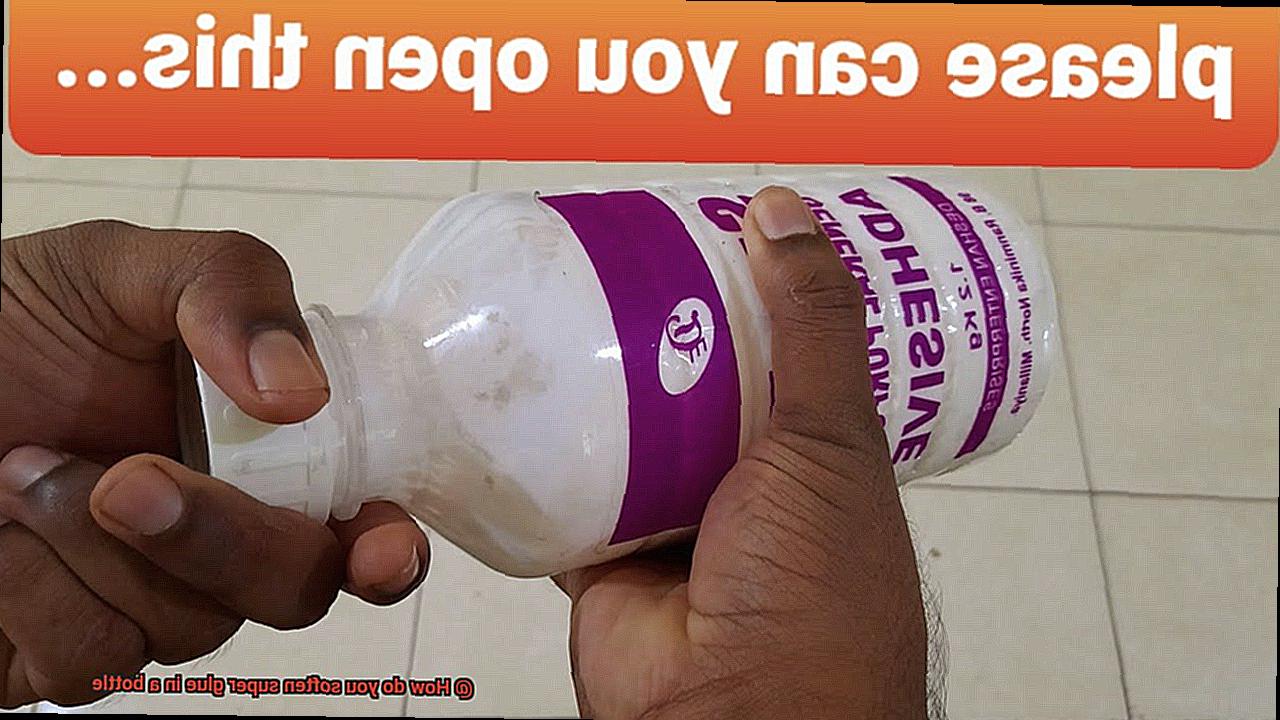
This article explores the power of acetone and its effectiveness in dissolving glue. With a few simple steps, you can overcome any sticky situation effortlessly.
Understand the Power of Acetone:
Acetone, a potent solvent commonly found in nail polish removers, paint thinners, and certain cleaning products, is known for its ability to dissolve super glue. Its chemical properties make it an ideal choice for removing stubborn adhesive.
Test for Compatibility:
Before proceeding with the acetone method, it’s crucial to test it on a small, inconspicuous area of the surface you intend to clean. This step ensures that the acetone does not damage or discolor the material.
Applying Acetone:
Begin by applying a small amount of acetone directly onto the dried super glue. Use a dropper or a cotton swab to control the amount and avoid excessive application.
Allow Time for Penetration:
Allow the acetone to sit on the glue for a few minutes, giving it ample time to penetrate and dissolve the bond between the glue and the surface. This will significantly ease the removal process.
Gently Scrape Off Softened Glue:
Using a plastic scraper or your fingernail, gently scrape off the softened glue. Exercise caution to avoid damaging the surface. If necessary, repeat the process until all traces of super glue are removed.
Cleanse the Area:
After successfully removing the glue, cleanse the area with soapy water to eliminate any residual acetone. This step ensures that no harmful chemicals remain on the surface.
Safety Precautions:
Always work in a well-ventilated area when using acetone due to its potentially harmful fumes. Avoid inhaling the fumes and keep the solvent away from open flames or sparks, as acetone is highly flammable. In case of accidental skin contact, promptly wash the affected area with soap and water.
Commercial Remover Method: Using a Commercial Remover to Soften the Glue
I’m here to share the secret weapon that will soften that adhesive in no time – the almighty commercial remover.
Commercial removers are specially formulated to target and dissolve super glue. They are readily available in most hardware stores, home improvement centers, and online retailers. These bad boys usually contain acetone or a similar solvent that breaks down the chemical bonds in the glue, making it easier to remove.
But before you go all gung-ho with that commercial remover, here’s a word of caution. Not all removers are suitable for all surfaces. Some might cause damage or discoloration, and nobody wants that. So, it’s always wise to test the product on a small, inconspicuous area before going all-in.
Alright, now let’s get down to business. Here’s how you can use a commercial remover to soften that pesky glue:
- Read the instructions: Before you start, take a moment to read and follow the instructions provided by the manufacturer. Safety first, people.
- Apply and wait: Put on your gloves and find a well-ventilated area to work in. Apply a small amount of the commercial remover directly onto the glued area. Now, be patient and let it work its magic for a few minutes. The exact time may vary depending on the product, so refer to those trusty instructions for guidance.
- Scrape away: Once the remover has had enough time to penetrate and soften the adhesive, grab a plastic scraper or use your trusty fingernail (careful not to damage it.) and gently scrape away the softened glue. Voila.
- Repeat if necessary: If there are still remnants of glue left behind, don’t panic. Just repeat the process until every last trace of adhesive has been banished.
- Clean up: After successfully removing all that gluey mess, give the area a good clean with some soap and water to remove any residue from the remover.
And remember, safety is paramount. Wear protective gear like gloves and safety glasses, work in a well-ventilated area, and keep the remover away from open flames or sparks.
If you’re still unsure about using a commercial remover or need some expert advice, don’t hesitate to consult a professional. They’ll guide you through the process and recommend the best solution for your specific situation.
Natural Degradation Method: Waiting for the Super Glue to Degrade Over Time
No need to panic or call for a superhero. There’s a natural degradation method that can soften super glue over time, without the need for any additional products or tools. So, sit back, relax, and let time work its magic.
Super glue, also known as cyanoacrylate adhesive, is a fast-acting and incredibly strong adhesive that forms an unyielding bond between surfaces. But like everything else in this world, it’s not invincible. Over time, super glue can naturally degrade and lose its adhesive properties.
The degradation process of super glue is influenced by various factors – temperature, humidity, and air exposure. When moisture from the air comes into contact with super glue, a chemical reaction called hydrolysis occurs. This reaction causes the glue to break down and lose its mighty grip.
However, it’s important to note that the natural degradation process of super glue is not an overnight miracle. It takes time – anywhere from several months to years – depending on the specific conditions. Patience is key when employing this method.
To facilitate the degradation process, optimal conditions must be provided for the super glue to degrade. This means exposing the bottle to air and moisture. Leave the bottle uncapped or partially open in a humid environment or near a source of moisture. By doing so, you can speed up the degradation process and bid farewell to that stubborn glue.
Keep in mind that this method may not provide immediate softening of super glue. It requires time and patience. Additionally, the effectiveness of this degradation method may vary depending on the brand and formulation of the super glue.
Safety Guidelines When Working with Super Glue
When working with super glue, safety should be your top priority. Here are some essential guidelines to keep in mind:
- Protect Your Skin: Always wear protective gloves when handling super glue. This powerful adhesive can bond quickly and firmly to your skin, so create a barrier between the glue and your hands.
- Work in a Well-Ventilated Area: Super glue can emit fumes that may be harmful when inhaled. Ensure proper airflow by working in a well-ventilated space. Open windows or use a fan to keep the air fresh and prevent respiratory issues.
- Mind Your Clothing: Be cautious not to get super glue on your clothes. It can bond quickly and permanently, ruining your favorite shirt. Consider wearing old clothes or an apron designated for your crafting adventures.
- Keep Out of Reach of Kids and Pets: Super glue’s strong adhesive properties can cause harm if ingested or if it gets into their eyes or mouth. Store it safely away from curious little hands and paws.
- Use Sparingly: Applying too much glue can lead to messy applications and excess bonding that may be difficult to manage. Remember, a little goes a long way.
- Clean and Dry Surfaces: Before applying super glue, ensure the surfaces are clean and dry. Grease, oil, or moisture can interfere with the bonding process and weaken the adhesive’s effectiveness.
- Avoid Touching Your Face: Resist the temptation to scratch that itch or adjust those glasses while working with super glue. Accidentally gluing your fingers to your face is not fun. Keep your hands clean and away from sensitive areas.
- Handling Accidents: If you get super glue on your skin, don’t panic. Soak the affected area in warm soapy water and gently try to separate the bonded surfaces using a soft cloth or cotton swab.
- Eye Contact: In case of accidental eye contact with super glue, immediately flush the affected eye with plenty of water for at least 15 minutes and seek medical attention promptly.
- Proper Storage: Store super glue in a cool and dry place, away from heat sources or direct sunlight. This will prevent unwanted reactions and extend its shelf life.
- Read the Instructions: Always read and follow the instructions provided by the manufacturer. Different brands may have specific safety precautions or recommendations.
U8SvmwTR5dM” >
Conclusion
In conclusion, there are several methods to soften super glue in a bottle. One effective approach is the heat method. Simply apply some heat using a hairdryer or immerse the bottle in hot water. This clever trick loosens the glue’s grip, making it easier to pour or remove. However, remember to be cautious and avoid overheating or damaging the bottle.
Another reliable method involves using acetone. Found in nail polish removers and paint thinners, acetone breaks down the chemical bonds in super glue, effectively dissolving it. Before applying acetone, always test it on a small area to ensure compatibility with the surface.
If you prefer ready-made solutions, commercial removers specifically designed for super glue can do the trick. These products contain solvents like acetone that efficiently dissolve the adhesive. Remember to carefully read and follow the manufacturer’s instructions and conduct a small-scale test before use.
For those who appreciate natural alternatives, waiting for super glue to degrade over time is an option. Exposing it to air and moisture aids this process, although patience is required as degradation can take months or even years.
When working with super glue, prioritizing safety is crucial. Always wear protective gloves, work in well-ventilated areas, and avoid contact with skin and eyes. Additionally, proper storage and adherence to manufacturer instructions are essential for safe handling.


